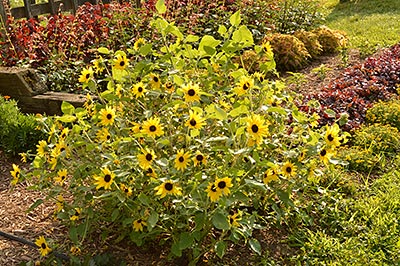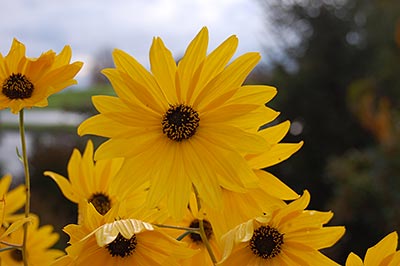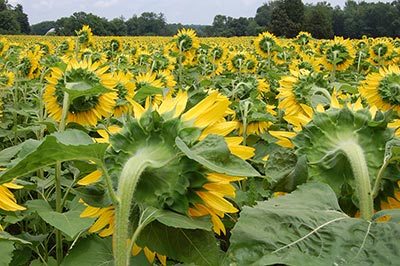
Sunfinity.
The autumn months are synonymous with fresh apple cider, donuts and for the garden, Chrysanthemums. I enjoy the many varieties and colors of Chrysanthemums and, aside from a few very hardy selections, I find them to be more ideal candidates for containers than additions to the Garden beds. This then begs the question of what to plant in the Garden? Finding colorful plants for September into October is often a challenge, since many have already completed their bloom. Yet, there remain some great plants and one plant that has consistently amazed me for its sunny impact and length of bloom is the Swamp Sunflower, Helianthus angustifolius.
Helianthus is in the Asteraceae or Aster Family and, with over 1,900 Genera and 32,900+ species, it would make one very large family gathering at Thanksgiving! In fact, Helianthus alone has over 70 species. The genus name was penned by the Swedish Botanist, Carl Linnaeus (1707-1778) in 1753 and is derived from the Greek Helios for sun and Anthos for flower. The botanical and common name of Sun Flower stems from the heliotropic nature of these plants, whereby the flower is able to move and follow the sun as it tracks Westward throughout the day (as the field of Sunflowers depict on the last page). The plants developed this ability to maintain the maximum reflectivity of the flower and heightened ability to attract pollinators. In Greek Mythology, this diurnal movement prompted the story of the water nymph Clytie who was infatuated with the sun god Apollo. For nine days she stared up at him as he traversed the sky. Without food she withered away and turned into a Sunflower, continuing to watch his daily travels for all of eternity!

Swamp Sunflower at Crystal Springs.
The type species or the plant by which the remainder of the species are compared is Helianthus annuus, the Common Sunflower. As the species epithet implies, it is an annual and is found throughout Western North America south into Northern Mexico. Seed hardy from zone 2-11, the coarse textured plant with pubescent stems and leaves rapidly grows to 5-10+ feet in height. The flowers have a whimsical quality and make for a very popular cut flower. Most of the hybrids produce one large flower, upwards of 12” in diameter per stalk, but if allowed to reseed, the seedlings are typically multi-branched with a number of smaller flowers. This plant has found multiple uses aside from ornamental, with the fruit being used for oil and food, and the birds love the fruits whether from a bag or right from the flower! Plants prefer full sun and well-drained soils. Recently, a more compact hybrid has come on the market called ‘Sunfinity' (pictured above). It displays a more compact habit to 3-4' tall and wide, with a continuum of 3-4” diameter flowers from June through September or early October. By comparison, the Swamp Sunflower (pictured at left at Crystal Springs and an individual flower below) is a long-lived perennial that prefers moist or water retentive soils and is native from Texas, northeast to Long Island. Also named by Carl Linnaeus in 1753, the species epithet is from the Latin angust for narrow and foli for leaf, describing the narrow leaves which can reach upwards of 6” long. The stout stems typically reaching 5-7' tall with a spread of 4-6'.

Swamp Sunflower .
One of the interesting aspects of the Asteraceae is the misleading appearance of any given ‘flower'. The word Aster is from the Greek Astēr, meaning star. It is a reference to how the flowers have a star-like center with the ‘petals' resembling the emanating rays of sunlight. In reality the flower is composed of not one, but 100's of small, individual flowers! This family was originally called the Compositae, since the ‘flowers' consist of a composite of many small flowers or florets. The light rays along the edge are ironically called Ray Florets and the circular flowers that compose the central star are called disc florets. The flowers open or mature from the outer edge inwards, with the Ray Florets opening or maturing first and the central disc florets last. All the florets are attached to a plate called a receptacle and the entire structure is called a flower head or capitulum. The showy outer ring of ray florets is typically 3 petals fused into one, strap-like ligule, whose function is to attract the pollinators. Depending on the genus, the ray florets can be sterile or fertile and bare seed. The central disc florets are circular in shape with 5 fused and severely reduced petals. In place of the typical calyx or leafy bracts that subtend the petals, there exists a thread-like structure called a pappus that ultimately aides in the dispersal of the seed. In dandelions, the parachute structure that allows the seeds to magically float about is the pappus. In Helianthus, the pappus matures into two scales that fall off when the fruit is mature. The florets sit upon an ovary which develops into a fruit called a cypsela. Often considered to be an achene, a cypsela and an achene are very similar in that they are both a dried fruit that contains a seed. The difference being a cypsela develops from a double ovary, while an achene develops from a single ovary. In both instances, only one seed is produced. Hence, when you are eating sunflower seeds, you are actually splitting open the dried husks of the fruit, allowing you to get to the edible inner seed!
For Swamp Sunflower, I have found it best to site the plant in a location that receives adequate moisture. After planting them several times in more well-drained location, the planting that has proven most successful over the past 10 years is at the base of a hill where it receives all the stormwater sheet flow from above (as seen above at Crystal Springs). The 2” diameter yellow flowers bloom profusely from late September through October and they look beautiful against the clear blue autumn skies. The plants look great paired with Winterberry Holly (Ilex verticillata), Blue Star Amsonia (Amsonia hubrichtii), Limelight Hydrangea (Hydrangea paniculata ‘Limelight') and even the now drying stems of Joe-Pye Weed (Eupatorium purpureum). The plants are also a host plant for the Silvery Checkerspot Butterfly and the seeds are much beloved by songbirds, Ruffled Grouse, Quail and Morning Doves. Consequently, it is best to leave the stems up through the winter months.
A champion plant for our native pollinators, Helianthus angustifolius remains an uncommon plant in many gardens, which to me defies logic. Easily grown, long-lived with a very sunny disposition, this is a ‘must have' plant for autumn gardens!


